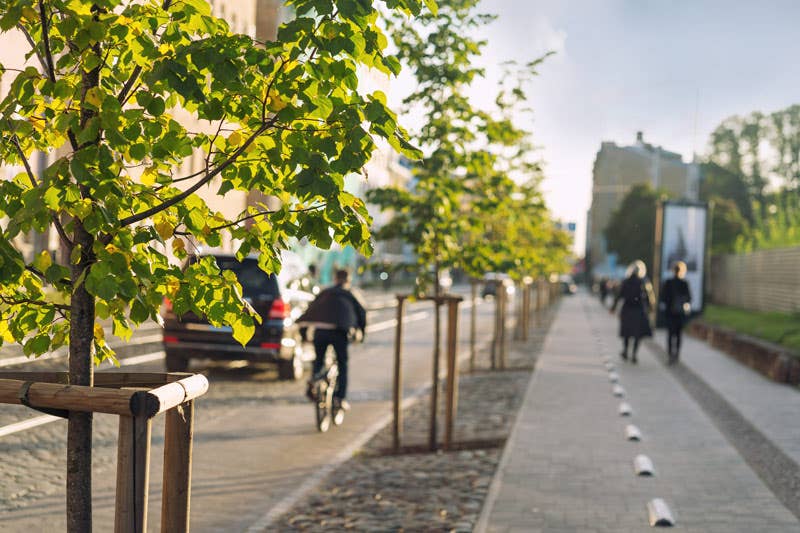Harnessing Urban Trees: Paving the Way for a Cooler Tomorrow
In the age of climate change, urban trees have become significant in mitigating rising temperatures and enhancing the quality of urban life.

[Dec 8, 2023: JD Shavit, The Brighter Side of News]
In the age of climate change, the significance of urban trees in mitigating rising temperatures and enhancing the quality of urban life has taken center stage. (CREDIT: Creative Commons)
In the age of climate change, the significance of urban trees in mitigating rising temperatures and enhancing the quality of urban life has taken center stage. A recent study from the University of Gothenburg has underscored the crucial role that trees play in cooling urban environments and how the surrounding pavement can either hinder or optimize their performance.
Trees have long been recognized as nature's air conditioners in urban areas. Their leafy canopies offer shade and cool the surrounding air, providing a respite from the scorching heat. However, to reap the full benefits of these green sentinels, we must ensure that they are given the right conditions to thrive.
The Impact of Pavement
Research conducted by Janina Konarska and her team at the University of Gothenburg delves into the intricate relationship between trees and their urban surroundings. Their findings reveal that the extent of paved surfaces surrounding a tree significantly affects its growth and cooling capabilities.
Related Stories
Konarska, the lead author of the study published in the journal Landscape and Urban Planning, emphasizes the importance of reducing the amount of asphalt encircling urban trees. "Our research shows that an important factor is how much of the area around the tree is paved," she explains.
The study focused on mature trees aged between 20 to 30 years, studying three different species: pin oak, horse chestnut, and common lime, across various locations in Gothenburg and Mölndal. The researchers examined a range of parameters, including crown density, tree growth, and transpiration—the process by which trees release water vapor from their leaves, akin to natural air conditioning.
The Grass Advantage
The study's most compelling revelation was the remarkable difference in tree growth and cooling capacity between trees surrounded by grass and those hemmed in by asphalt. Trees encircled by grass exhibited exceptional growth, standing on average 2.6 meters taller with crowns 1.3 meters wider than their pavement-surrounded counterparts.
Photographs of study sites. (CREDIT: Science Direct)
Moreover, the trees with grassy surroundings boasted a 61 percent denser crown and provided twice as much cooling effect to the environment. The cooling effect of trees primarily depends on the density of their canopy, and the release of water vapor during transpiration further enhances their air-conditioning capabilities.
Pavement's Detrimental Effects
One of the key reasons behind this disparity lies in the nature of pavement itself. Asphalt and concrete surfaces tend to trap heat, leading to higher air temperatures above them compared to areas covered with grass or soil. This heat retention exacerbates the urban heat island effect, making cities warmer than their rural surroundings.
Predawn and midday leaf water potentials (ΨPD and ΨMD, top row), stomatal conductance (gs, second row), transpiration rates (E, third row) and whole plant leaf-area specific hydraulic conductance (Kplant, bottom row) measured in A. (CREDIT: Science Direct)
Additionally, hardened surfaces hinder rainwater from reaching the roots of the trees, further impeding their growth and overall health. This, coupled with the elevated air temperatures, can be detrimental to urban trees.
Species Sensitivity
The study also shed light on the varying sensitivity of different tree species to the surrounding pavement. Horse chestnut, for instance, demonstrated a higher tolerance for hardened surfaces compared to pin oak and common lime. However, when optimal conditions prevailed, horse chestnut still lagged behind its counterparts in terms of performance.
Janina Konarska, researcher at the University of Gothenburg. (CREDIT: Robert Karlsson)
Therefore, while the choice of tree species is undoubtedly essential, the researchers concluded that the proximity of pavement to the tree trunk plays a pivotal role in determining the cooling efficacy of urban trees.
Investing in Urban Greenery
Planting and nurturing trees in urban areas come with their challenges. It is often a costly and time-consuming endeavor to establish and maintain mature trees. In densely populated urban landscapes, creating open spaces around trees can be particularly challenging.
Lasse Tarvainen, an environmental scientist at the University of Gothenburg. (CREDIT: Lasse Tarvainen)
Lasse Tarvainen, an environmental scientist at the University of Gothenburg, stresses the importance of investing in the well-being of urban trees. "You have to do the best you can when planting trees in urban areas," Tarvainen advises. "If it is difficult to create open spaces around the trees, it is a good idea to invest in better soil and preferably to water the tree. It is important that we take care of the trees; they are valuable in many ways."
In the quest for cooler, greener cities, investing in the urban canopy is not just an environmental concern but a societal one. As our cities continue to grow and evolve, the importance of balancing development with green infrastructure becomes ever more critical. Trees, it seems, hold the key to a more sustainable and pleasant urban future.
For more science and technology news stories check out our New Discoveries section at The Brighter Side of News.
Note: Materials provided above by UC Riverside. Content may be edited for style and length.
Like these kind of feel good stories? Get the Brighter Side of News' newsletter.
Joshua Shavit
Science & Technology Writer | AI and Robotics Reporter
Joshua Shavit is a Los Angeles-based science and technology writer with a passion for exploring the breakthroughs shaping the future. As a contributor to The Brighter Side of News, he focuses on positive and transformative advancements in AI, technology, physics, engineering, robotics and space science. Joshua is currently working towards a Bachelor of Science in Business Administration at the University of California, Berkeley. He combines his academic background with a talent for storytelling, making complex scientific discoveries engaging and accessible. His work highlights the innovators behind the ideas, bringing readers closer to the people driving progress.



